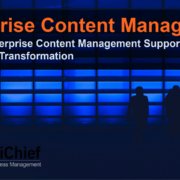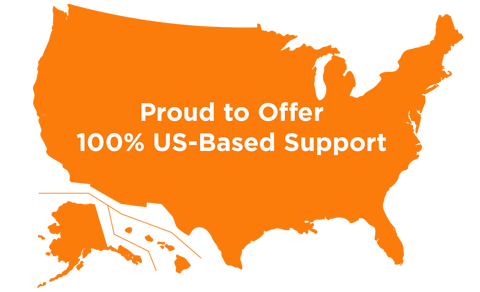How Does a Content Management System Work?
Your organization’s content is the linchpin of its success. This content, comprised of invoices, sales orders, onboarding forms, employee files, interdepartmental correspondence, and more, is the fuel that drives your business forward. Without a reliable way to manage this content, such as a content management system (CMS) or Enterprise Content Management (ECM) system, information cannot be passed from user to user in an efficient manner. But how does a content management system work? And why is it so important for enterprises?
How Content Management Works in Favor of Your Business
When information stops flowing through an organization, operations come to a grinding halt and your ability to generate revenue is compromised. On a normal day, you probably don’t spend a lot of time thinking about how content flows through your organization, but every task you perform is integral to this process.
Due to the collaborative nature of many business processes (i.e., Accounts Payable, Accounts Receivable, Human Resources, Customer Service, etc.) breakdowns in your content management cycle are rarely isolated incidences. One small hiccup can lead to late payments, process bottlenecks, and dissatisfied customers and business partners. Effective content management helps you mitigate, or altogether eliminate, deficiencies in your content management cycle.
How does a content management system achieve this goal? Below, we explore the process flow and features that can be utilized to your advantage when implementing a best-in-class ECM system to help you manage your content.
Information Is Captured From All Forms of Content
For enterprises, the stream of information flooding into your organization at all times can be very difficult to maintain, organize, and process. Sometimes, this content is structured, which simplifies the process of handling it. However, a large volume of this information is unstructured or requires some form of manual processing to become structured. One of the most important concepts of content management is the structuring of unstructured information. In terms of accelerating business processes, structured data has far more utility than unstructured data.
Capture technology is an integral component of ECM. By utilizing Optical Character Recognition (OCR) software to capture information from all forms of content, your organization can begin to add structure to its information at scale. Not every piece of OCR software is up to the task. Consider the differences between basic OCR software and an enterprise-class solution:
- Basic OCR: “Scans” a paper document and creates a digital replica that can be stored and retrieved electronically.
- Advanced or Enterprise OCR: “Reads” paper and electronic documents and identifies key information, and tags/archives it accordingly.
More advanced forms of OCR are preferred by enterprises because they utilize other advanced technologies, such as machine learning, to capture and process content intelligently. The value of this added intelligence will be made clear in the next section.
Content Is Tagged, Indexed, and Archived
Once an organization’s content has been digitized, it still needs to be tagged with metadata so that users can search for and retrieve the information they are looking for. With basic OCR, this information must be keyed in manually. However, with an advanced, enterprise-class OCR component, this step can be handled automatically by your ECM system, saving your business time and money.
Advanced OCR can recognize what type of content it is capturing as well as the specific datapoints found on the content. For example, if you receive an invoice in the mail for x number of widgets, OCR software can not only create a digital replica but also tag the invoice based on any number of identifying criteria, index the information accordingly, and archive the invoice in a secure digital repository.
But that’s not all. It can also recognize the process that needs to be carried out to satisfy the invoice request.
Content Is Processed Through Workflows
Once the process has been identified (i.e., an invoice is received so the AP workflow must be carried out), you can start managing your content through digital workflows that follow your unique business rules. Workflows can be customized to fit your exact processes. Continuing with the invoice processing example, you can set permissions based on the value of an invoice, the vendor that sent the invoice, or the time at which the invoice was received. These are a few common examples but you can tailor your workflows as needed to account for all the nuances in your process — no matter how specific.
Depending on the complexity of your content management system, your organization may also be able to automate workflows, greatly reducing the amount of time it takes to process an invoice from start to finish. Another important benefit of workflows is they help protect your company against duplicate payments, missed early payment discounts, and other potential filing and processing errors. In summary, the ability to capture content, tag it, index it, store it, and process it through workflows are all fundamental to an advanced, enterprise-class content management system.
Automated Retention Policies Are Executed
So far, we’ve covered three of the key features that help answer the central question:
How does a content management system work?
However, the capabilities of your chosen content management or ECM system must also account for documents that need to be terminated in addition to those that must be preserved for a certain period of time. Otherwise, your business could find itself in hot water when the time comes to provide evidence of regulatory compliance. Content management systems (typically ECM), can also automate retention policies to ensure that your organization is prepared for an audit at the drop of a hat. This makes dealing with HIPPA, SOX, and other regulations a breeze — even if your company deals with hundreds of thousands of documents a year (or more).
Managing Your Enterprise Content With ECM
When an organization manages its content with ECM, it helps them to eliminate paper dependence, streamline and standardize business processes, reduce risk, boost productivity to all-time highs, serve better customer experiences, and provide superior transparency over all connected business operations. Whether you deploy ECM in Accounts Payable, Accounts Receivable, Human Resources, Customer Service, or any other department that processes large volumes of information, your organization will experience a multitude of benefits only possible with a comprehensive content management plan backed by a best-in-class ECM system.








